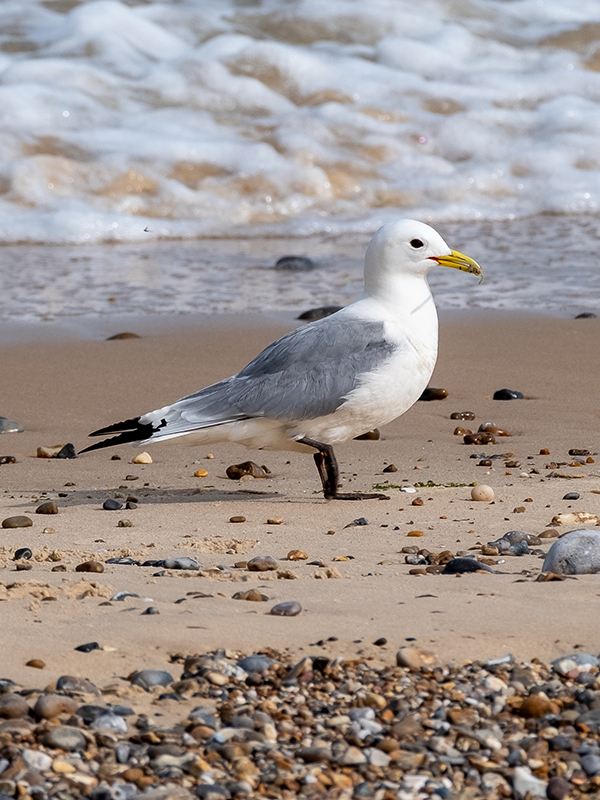Have you stood on Lowestoft promenade and looked out to sea and wondered what these are?
The energy giants Orstead and Scottish Power have built offshore kittiwake “hotels” which are offshore nesting sites that give the kittiwakes artificial cliffs to nest on. These are easily seen from the promenade, you’ll also see land based hotels located on seaside industrial sites around Lowestoft. Each hotel houses about 430 nesting pairs.
Kittiwakes are an endangered sea bird that looks a lot like a herring gull, but is smaller and won’t chase you and steal your chips! They visit Lowestoft once a year to nest and during that time the gull population in Lowestoft booms.
Kittiwakes are gentle-looking, medium-sized gulls with a small yellow bill and a dark eye. They have a grey back with white underneath. Their legs are long and black. In flight, the black wing-tips show no white, unlike other gulls, and look as if they have been ‘dipped in ink’. Kittiwakes are protected by law because of their endangered (“red listed”) status.

Kittiwake

Herring Gull
© A D Vison Drone Man
Lowestoft and Sizewell are the only locations between Kent and Humberside with thriving kittiwake colonies and Lowestoft is taking the lead in building artificial nesting sites so that this endangered seabird can reproduce and thrive.
Kittiwakes are the only gull species that are exclusively cliff-nesting. The artificial nesting sites in Lowestoft are built to mimic their natural cliffside nesting environment and to discourage them from nesting in the eaves and roofs of seaside buildings, where the chicks are at risk of predation by cats and other birds. After breeding, kittiwakes move out into the Atlantic where they spend the winter.
In contrast to the dappled chicks of other gull species, kittiwake chicks are downy and white since in the wild they are under relatively little threat of predation, as the nests are on extremely steep cliffs. Unlike other gull chicks which wander around as soon as they can walk, kittiwake chicks instinctively sit still in the nest to avoid falling off.
Kittiwakes can live up to 28 years, so the kittiwake you see as a child could be the kittiwakes your grandchildren see! They can start to breed when they are 3 years old and they lay 2-3 eggs and the young spend 5-7 weeks in the nest. Once they fledge, they migrate with the rest of their flock back out to sea to hunt small fish and we won’t see them back in town until the next season, when the cycle starts all over again.
Have you stood on Lowestoft promenade and looked out to sea and wondered what these are?
The energy giants Orstead and Scottish Power have built offshore kittiwake “hotels” which are offshore nesting sites that give the kittiwakes artificial cliffs to nest on. These are easily seen from the promenade, you’ll also see land based hotels located on seaside industrial sites around Lowestoft. Each hotel houses about 430 nesting pairs.
Kittiwakes are an endangered sea bird that looks a lot like a herring gull, but is smaller and won’t chase you and steal your chips! They visit Lowestoft once a year to nest and during that time the gull population in Lowestoft booms.
Kittiwakes are gentle-looking, medium-sized gulls with a small yellow bill and a dark eye. They have a grey back with white underneath. Their legs are long and black. In flight, the black wing-tips show no white, unlike other gulls, and look as if they have been ‘dipped in ink’. Kittiwakes are protected by law because of their endangered (“red listed”) status.
© A D Vison Drone Man
Lowestoft and Sizewell are the only locations between Kent and Humberside with thriving kittiwake colonies and Lowestoft is taking the lead in building artificial nesting sites so that this endangered seabird can reproduce and thrive.
Kittiwakes are the only gull species that are exclusively cliff-nesting. The artificial nesting sites in Lowestoft are built to mimic their natural cliffside nesting environment and to discourage them from nesting in the eaves and roofs of seaside buildings, where the chicks are at risk of predation by cats and other birds. After breeding, kittiwakes move out into the Atlantic where they spend the winter.
In contrast to the dappled chicks of other gull species, kittiwake chicks are downy and white since in the wild they are under relatively little threat of predation, as the nests are on extremely steep cliffs. Unlike other gull chicks which wander around as soon as they can walk, kittiwake chicks instinctively sit still in the nest to avoid falling off.
Kittiwakes can live up to 28 years, so the kittiwake you see as a child could be the kittiwakes your grandchildren see! They can start to breed when they are 3 years old and they lay 2-3 eggs and the young spend 5-7 weeks in the nest. Once they fledge, they migrate with the rest of their flock back out to sea to hunt small fish and we won’t see them back in town until the next season, when the cycle starts all over again.

Kittiwake
